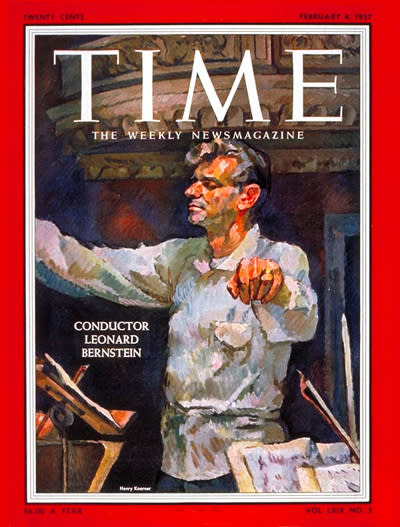Inside TIME's 1957 Cover Story on Leonard Bernstein

- Oops!Something went wrong.Please try again later.
- Oops!Something went wrong.Please try again later.
Bradley Cooper as Leonard Bernstein in <i>Maestro</i>. Credit - Courtesy of Netflix
In Maestro, in select theaters Nov. 22 and on Netflix Dec. 20, Bradley Cooper stars as Leonard Bernstein, one of the greatest composers of the 20th century. The film, also directed and co-written by Cooper alongside Josh Singer, focuses on the composer’s tumultuous marriage to the Costa Rican–Chilean actor Felicia Montealegre (played by Carey Mulligan) and the affairs he had with men while married to her.
As the movie depicts in a frantic opening sequence, Bernstein’s big break occurred on Nov. 14, 1943, when, at 25, he conducted the New York Philharmonic at Carnegie Hall—replacing ailing conductor Bruno Walter. (In the movie, he swoops in at the last minute—without a rehearsal—but the magazine story says he had been practicing in case he was needed.) From there, he went on to become famous for popular works like West Side Story and the score for On the Waterfront.
TIME detailed Bernstein's eccentricities in a Feb. 4, 1957 cover story hailing him as the first U.S.-born conductor with an international reputation. Among the qualities that shine through in both the movie and the cover story are that Bernstein had boundless energy, was extremely extroverted, and was often stretched too thin, which took a toll on his personal relationships.

The cover story doesn’t focus on his marriage to Montealegre, but there is one mention of their relationship, and it’s all about the tensions between the duo:
TIME was also open about Bernstein’s fluid sexuality, though not in the 1957 story. His 1990 obituary noted that “He reveled in his private life as a homosexual,” though he remained married to Montealegre until her death in 1978.
As a metaphor for his professional endeavors, the 1957 magazine story invoked the image of “a juggler whose oranges have suddenly acquired a demonic will of their own,” adding, “Bernstein today finds himself with five careers in the air at once.” The story called him the “Mickey Mantle of Music,” and waxed poetic about Bernstein’s charm, writing, “He exudes sex appeal like a leaky electric eel…when he decides to give somebody the full charge of charm, the eyes glow like coals that have been blown on. The educated nostrils flare just the least little bit, and the rich low cello voice begins to murmur intelligently.”
The scene in Maestro in which he is multitasking on the toilet—conversing with people and working—has some basis in truth, as TIME wrote that Bernstein was known for writing music in men’s rooms, as well as in taxis, airplanes, and railroad stations.
Read TIME’s Leonard Bernstein 1957 cover in the TIME Vault here.
Write to Olivia B. Waxman at olivia.waxman@time.com.

